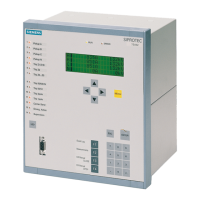Ground Fault Protection 64, 67N(s), 50N(s), 51N(s)
Depending on the variant, the fourth current input of the multi-functional protection relays Depending on the
variant, the fourth current input of the multi-functional protection relays 7SJ62/64 is equipped either with a
sensitive input transformer or a standard transformer for 1/5 A. is equipped either with a sensitive input trans-
former or a standard transformer for 1/5 A.
In the first case, the protective function is designed for ground fault detection in isolated or compensated
systems due to its high sensitivity. It is not really suited for ground fault detection with large ground currents
since the linear range is transcended at about 1.6 A at the sensitive ground fault detection relay terminals.
If the relay is equipped with a standard transformer for 1/5 A currents, large currents can also be detected
correctly.
This function can operate in two modes. The standard procedure, the “cos-φ– / sin-φ measurement”, evaluates
the part of the ground current perpendicular to the settable directional characteristic.
The second procedure, the “U0/I0-φ measurement”, calculates the angle between ground current and
displacement voltage. For this procedure, two different directional characteristics can be set.
Applications
•
Sensitive ground fault detection may be used in isolated or compensated systems to detect ground faults,
to determine phases affected by ground faults, and to specify the direction of ground faults.
•
In solidly or low-resistance grounded systems, sensitive ground fault detection is used to detect high
impedance ground faults.
•
This function can also be used as supplementary ground fault protection.
Ground Fault Detection for cos-ϕ / sin-ϕ Measurement (Standard Method)
Voltage Element
The voltage element relies on a pickup initiated by the displacement voltage V
0
or 3 · V
0
. Additionally, the
faulty phase is determined. The displacement voltage V
0
can be directly applied to the device, or the summa-
tion voltage 3 · V
0
can be calculated according to the connection type of the voltage transformer (see also
Parameter 213 VT Connect. 3ph in Section 2.1.3 Power System Data 1). When setting Van, Vbn, Vcn,
the calculation of the summation voltage 3 · V0 is based on the three phase-to–ground voltages. The three
voltage inputs must therefore be connected to the voltage transformers in a grounded-wye configuration.
When setting Vab, Vbc, VGnd, the three phase-to-ground voltages of both connected phase-to-phase
voltages and the connected displacement voltage are calculated. If the device is only provided with phase-to-
phase voltages, it is not possible to calculate a displacement voltage from them. In this case the direction
cannot be determined.
If the displacement voltage is calculated, then:
3 ·
V
0
= V
A
+ V
B
+ V
C
If the displacement voltage is directly applied to the device, then V
0
is the voltage at the device terminals. It is
not affected by parameter Vph / Vdelta (address 206).
The displacement voltage is used both to detect a ground fault and to determine direction. When the voltage
element picks up, a preset time delay must elapse before detection of the displacement voltage is reported to
be able to record stable measurement quantities. The time delay can be configured (T-DELAY Pickup) and
its factory setting is 1 s.
Pickup performed by the displacement voltage can be delayed (64-1 DELAY) for tripping.
It is important to note that the total tripping time then consists of the displacement voltage measurement
time (about 50 ms) plus the pickup time delay T-DELAY Pickup Pickup plus the tripping delay 64-1
DELAY.
After the voltage element picks up due to detection of a displacement voltage, the grounded phase is identi-
fied, if possible. For this purpose, the individual phase-to-ground voltages are measured or calculated, irre-
spective of the connection type of the voltage transformers. If the voltage magnitude for any given phase falls
2.12
2.12.1
Functions
2.12 Ground Fault Protection 64, 67N(s), 50N(s), 51N(s)
172 SIPROTEC 4, 7SJ80, Manual
E50417-G1140-C343-A8, Edition 12.2017

